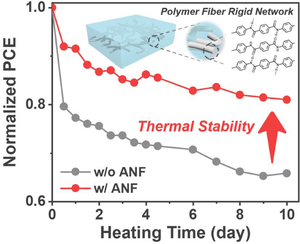Nano-Micro Letters ( IF 31.6 ) Pub Date : 2024-06-18 , DOI: 10.1007/s40820-024-01442-0 Qiao Zhou , Cenqi Yan , Hongxiang Li , Zhendong Zhu , Yujie Gao , Jie Xiong , Hua Tang , Can Zhu , Hailin Yu , Sandra P. Gonzalez Lopez , Jiayu Wang , Meng Qin , Jianshu Li , Longbo Luo , Xiangyang Liu , Jiaqiang Qin , Shirong Lu , Lei Meng , Frédéric Laquai , Yongfang Li , Pei Cheng

|
Organic photovoltaics (OPVs) need to overcome limitations such as insufficient thermal stability to be commercialized. The reported approaches to improve stability either rely on the development of new materials or on tailoring the donor/acceptor morphology, however, exhibiting limited applicability. Therefore, it is timely to develop an easy method to enhance thermal stability without having to develop new donor/acceptor materials or donor–acceptor compatibilizers, or by introducing another third component. Herein, a unique approach is presented, based on constructing a polymer fiber rigid network with a high glass transition temperature (Tg) to impede the movement of acceptor and donor molecules, to immobilize the active layer morphology, and thereby to improve thermal stability. A high-Tg one-dimensional aramid nanofiber (ANF) is utilized for network construction. Inverted OPVs with ANF network yield superior thermal stability compared to the ANF-free counterpart. The ANF network-incorporated active layer demonstrates significantly more stable morphology than the ANF-free counterpart, thereby leaving fundamental processes such as charge separation, transport, and collection, determining the device efficiency, largely unaltered. This strategy is also successfully applied to other photovoltaic systems. The strategy of incorporating a polymer fiber rigid network with high Tg offers a distinct perspective addressing the challenge of thermal instability with simplicity and universality.
中文翻译:

具有高玻璃化转变温度的聚合物纤维刚性网络增强了有机光伏的稳定性
有机光伏(OPV)需要克服热稳定性不足等限制才能实现商业化。报道的提高稳定性的方法要么依赖于新材料的开发,要么依赖于定制供体/受体形态,然而,其适用性有限。因此,现在是时候开发一种简单的方法来增强热稳定性,而无需开发新的供体/受体材料或供体-受体增容剂,或引入其他第三种组分。在此,提出了一种独特的方法,基于构建具有高玻璃化转变温度(T g )的聚合物纤维刚性网络来阻止受体和供体分子的运动,以固定活性层形态,并且从而提高热稳定性。采用高T g 一维芳纶纳米纤维(ANF)进行网络构建。与无 ANF 的对应物相比,具有 ANF 网络的倒置 OPV 具有卓越的热稳定性。加入 ANF 网络的活性层比不含 ANF 的活性层表现出明显更稳定的形态,从而使决定器件效率的电荷分离、传输和收集等基本过程基本保持不变。该策略也成功应用于其他光伏系统。将聚合物纤维刚性网络与高 T g 相结合的策略提供了一个独特的视角,以简单和通用的方式解决热不稳定性的挑战。






































 京公网安备 11010802027423号
京公网安备 11010802027423号